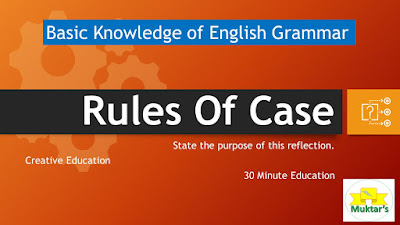Rules of Case
Case
(কারক)
Section 1:
Sentence
এ কোন thing বা pronoun এর সাথে অন্যান্য word বা শব্দের যে সম্পর্ক থাকে তাকে Case বলে।
ইংরেজিতে thing বা pronoun এর Case সাধারনত পাঁচ রকমের হয়ে থাকে। এগুলো হল-
1. Nominative
case
2. Objective
case
3. Possessive
case
4. Vocative
case
5. Dative
case
Note: Dative case কে সাধারনত স্বতন্ত্র কারক হিসেবে গণ্য করা হলেও আধুনিক English grammer এটিকে object তথা Objective case রুপে গণ্য করে।
তাই English language
structure এ মূলত চার প্রকার case ই আলোচিত হয়।
Nominative case:
যখন কোন thing বা pronoun কর্তা রুপে ব্যবহৃত হয় তখন তাকে Nominative case বলে।
কে
(who) অথবা (what) কি দ্বারা
প্রশ্ন করলে Nominative পাওয়া যাবে ।
For instance/Example:
-
Orin goes to class. [কে (who) স্কুলে যায়?]
এছাড়াও pronoun, modifier,Infinitive, "ing" word, verbal thing, state, proviso, and so forth.
Nominative case রূপে ব্যবহৃত হয়।
Nominative
রূপে thing - Orin goes to
class.
Nominative
রূপে pronoun – He visited
Khulna.
Nominative
রূপে modifier – The poor
live close by to mouth.
Nominative
রূপে infinitive – To
blunder is human.
Nominative
রূপে "ing" word
– Walking is a decent exercise.
Nominative
রূপে verbal thing – The
perusing of paper is a decent propensity.
Nominative
রূপে state – A man of
letters came here.
Nominative
রূপে statement – What he
says is known to all.
Objective/ target case:
যখন কোন thing বা pronoun কর্ম রুপে ব্যবহৃত হয় তখন তাকে Objective case বলে।
কাকে
(whom) অথবা কি (what) দ্বারা
প্রশ্ন করলে objective পাওয়া যাবে ।
-
Rahim peruses a book. (rahim কী পড়ছে? - book)
-
The pony kicked the kid. (কাকে kick করেছে? – the kid)
 |
| Rules of Case #30minuteeducation |
Objective/Target
case দুই প্রকার:
Accusative
case-কোন sentence এ যদি বস্তুবাচক thing – action word এর object রূপে বসে, তবে তাকে Accusative case বলে।
-
He purchased a vehicle. (vehicle বস্তুবাচক thing)
Dative
case – কোন sentence এ যদি ব্যেক্তিবাচক thing – action word এর object রূপে বসে, তবে তাকে Dative case বলে।
-
I like the man. (The man ব্যেক্তিবাচক thing)
এছাড়াও thing, pronoun,
descriptive word, infinitive, "ing" word, verbal thing, express,
proviso, and so forth. Target case রূপে ব্যবহৃত হয়।
Target
case রূপে thing – He peruses
the Quran.
👇👇👇
....Flow Chart.....
Target
case রূপে pronoun – We called
him.
Target
case রূপে descriptive word –
He helps poor people.
Target
case রূপে infinitive – I need
to rest.
Target
case রূপে verbal thing – I
like the playing of cricket.
Target
case রূপে express – I met a
man of parts.
Target
case রূপে proviso – I know how
he did it.
Section
3
Possessive
case:
অধিকার
বা কর্তৃত্ব বোঝাতে । “কার” প্রশ্নের উত্তর দেয়।
-
This is Ram's book. (কার বই-Ram এর)
-
These are Shakespeare's plays.(কার নাটক - Shakespeare এর)
Arrangementof Possessive case:
1. শেষে 's' বিহীন particular thing এর সাধারণত Apostrophe ও ('s) যোগ করে Possessive করা হয়।
এটা জীবিত thing এর ক্ষেত্রে হয়।
যেমন-Shawkot's book,
kamal's pen, mother's glass, child's toy.
2. শেষে 's' যুক্ত particular thing এর শেষে শুধু Apostrophe যোগ করে Possessive করা হয়।
যেখানে স-ধ্বনি একাধিক থাকে।
যেমন-jesus' discourse,
brutass' vehicle, keates' sonnet.
3. শেষে 's' বিহীন plural thing এর সাধারণত Apostrophe ও ('s) যোগ করে Possessive করা হয়।
যেমন-ladies'
co-employable, kids' park, men's dress, individuals' republic.
4. শেষে 's' যুক্ত plural thing এর শেষে শুধু Apostrophe যোগ করে Possessive করা হয়।
যেমন-young men's school,
young ladies' school, mariners' top, siblings' nursery.
5. Compound thing এর শেষে Apostrophe ও ('s) যোগ করে Possessive করা হয়।
যেমন-brother by marriage
home, Inspector-general's office.
6. Furthermore, দ্বারা যুক্ত একাধিক thing যৌথ অধিকার প্রকাশ করলে শেষের thing টির সাথে ('s) যোগ করতে হয়।
যেমন-Rahim and Karim's
level. Sami and Rahi's mom.
7. সাধারণত ব্যক্তির ক্ষেত্রে ('s) বসিয়ে বা তার পূর্বে of বসিয়ে Possessive করা হয়।
যেমন-Rahim's hen or The
hen of Rahim. Rabbi's goat or the goat of rabbi.
8. অচেতন পদার্থের ক্ষেত্রে ('s) না বসিয়ে of বসিয়ে Possessive করতে হয়।
যেমন-
Off base – The Chair's legs are broken.
Right
– The legs of seat are broken.
9. সময়, দুরুত্ব ও ওজন প্রকাশক thing এর সাথে (s') যোগ করে Possessive করতে হয়।
যেমন – Three days' leave,
A yard's length, A ton's weight.
Vocative
case:
Go
there, Rahim. May I come in sir.
উপরের sentence দুটিতে Rahim and sir দুটি thing এ সম্বোধন করে কিছু বলা আছে।
এখানে thing দুটির সাথে স্ব বাক্য দুটির অপর অংশ দুটির সাথে যে সম্পর্ক তাই Vocative case।
এক কথায় বাক্যে thing এর মাধ্যমে কাউকে কে সম্বোধন করে কিছু বলা হলে তার Vocative case হয়। একে nominative location বা instance of address ও বলা হয়।
যেমন – Brother, might I
be able to take your pen?
Farewell, mother. Come here. Go there.
Hello Viewers,
You can check it out here another English Grammar link ...👇👇👇👇👇
If you like my content, feel free to share it on your favorite social network.
Author,
#Muktar_Hossain
Thank you....









0 Comments
Please do not enter any spam link in the comment box.